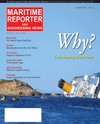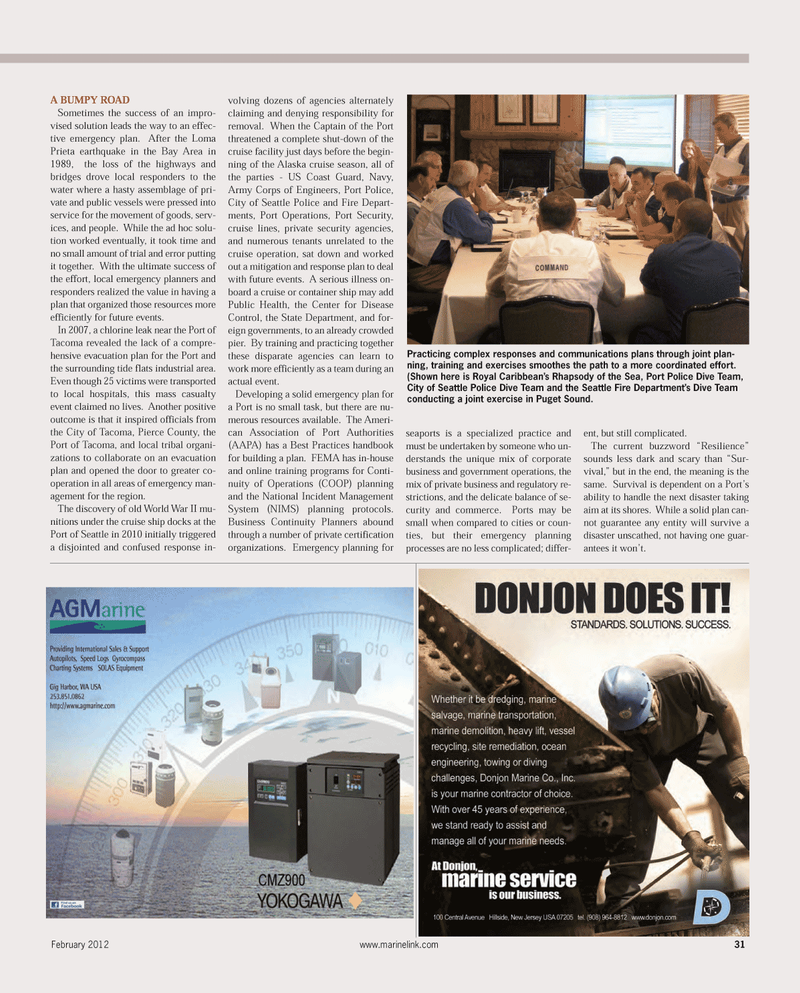
Page 31: of Maritime Reporter Magazine (February 2012)
Cruise Shipping Annual
Read this page in Pdf, Flash or Html5 edition of February 2012 Maritime Reporter Magazine
February 2012www.marinelink.com 31A BUMPY ROAD Sometimes the success of an impro-vised solution leads the way to an effec- tive emergency plan. After the Loma Prieta earthquake in the Bay Area in 1989, the loss of the highways and bridges drove local responders to the water where a hasty assemblage of pri- vate and public vessels were pressed into service for the movement of goods, serv- ices, and people. While the ad hoc solu- tion worked eventually, it took time and no small amount of trial and error puttingit together. With the ultimate success of the effort, local emergency planners and responders realized the value in having a plan that organized those resources more efficiently for future events. In 2007, a chlorine leak near the Port ofTacoma revealed the lack of a compre- hensive evacuation plan for the Port and the surrounding tide flats industrial area.Even though 25 victims were transported to local hospitals, this mass casualtyevent claimed no lives. Another positive outcome is that it inspired officials from the City of Tacoma, Pierce County, the Port of Tacoma, and local tribal organi- zations to collaborate on an evacuation plan and opened the door to greater co-operation in all areas of emergency man- agement for the region. The discovery of old World War II mu- nitions under the cruise ship docks at thePort of Seattle in 2010 initially triggereda disjointed and confused response in-volving dozens of agencies alternately claiming and denying responsibility for removal. When the Captain of the Port threatened a complete shut-down of the cruise facility just days before the begin- ning of the Alaska cruise season, all of the parties - US Coast Guard, Navy, Army Corps of Engineers, Port Police,City of Seattle Police and Fire Depart-ments, Port Operations, Port Security, cruise lines, private security agencies, and numerous tenants unrelated to thecruise operation, sat down and worked out a mitigation and response plan to deal with future events. A serious illness on- board a cruise or container ship may addPublic Health, the Center for DiseaseControl, the State Department, and for- eign governments, to an already crowded pier. By training and practicing together these disparate agencies can learn towork more efficiently as a team during an actual event. Developing a solid emergency plan for a Port is no small task, but there are nu- merous resources available. The Ameri- can Association of Port Authorities (AAPA) has a Best Practices handbook for building a plan. FEMA has in-house and online training programs for Conti-nuity of Operations (COOP) planningand the National Incident ManagementSystem (NIMS) planning protocols.Business Continuity Planners aboundthrough a number of private certification organizations. Emergency planning for seaports is a specialized practice andmust be undertaken by someone who un- derstands the unique mix of corporatebusiness and government operations, the mix of private business and regulatory re- strictions, and the delicate balance of se-curity and commerce. Ports may besmall when compared to cities or coun-ties, but their emergency planning processes are no less complicated; differ- ent, but still complicated. The current buzzword ?Resilience? sounds less dark and scary than ?Sur- vival,? but in the end, the meaning is the same. Survival is dependent on a Port?s ability to handle the next disaster taking aim at its shores. While a solid plan can- not guarantee any entity will survive a disaster unscathed, not having one guar- antees it won?t. Practicing complex responses and communications plans through joint plan- ning, training and exercises smoothes the path to a more coordinated effort. (Shown here is Royal Caribbean?s Rhapsody of the Sea, Port Police Dive Team, City of Seattle Police Dive Team and the Seattle Fire Department?s Dive Team conducting a joint exercise in Puget Sound. MR Feb.12 # 4 (26-33):MR Template 2/6/2012 1:15 PM Page 31

 30
30

 32
32
